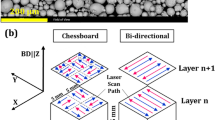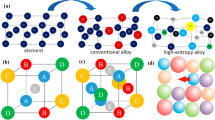Abstract
The present work discusses the evolution of grain boundary structure during thermomechanical processing and its effect on sensitization behavior in a nickel-based superalloy. Alloy 600 was deformed to varied degrees of strain (4–25%) using hot rolling followed by annealing at 1000 °C for 10 min followed by water quenching. Structure of the grain boundary was analyzed with reference to various parameters, such as grain boundary character distribution, twin-related domains, misorientation, and triple junction distribution. Each thermomechanically processed sample was heat-treated at 650 °C for 24 h before studying its sensitization behavior. The effect of structure of the grain boundary on sensitization was assessed through double loop electrochemical potentiokinetic reactivation test and measured in terms of degree of sensitization (DOS). DOS was found to be in a direct relation with the fraction of random high-angle grain boundaries and their connectivity, while it was inversely related to the fraction of low-Σ coincidence site lattice boundaries and special triple junctions. Residual strain and the fraction of low-angle grain boundaries were found to be weakly related to DOS. We show that a simple parameter can be used to predict the combined effect of all these factors on sensitization behavior.












Similar content being viewed by others
References
Friend W (1980) Corrosion of nickel and nickel-base alloys. Wiley, New York
Smith WF (1993) Structure and properties of engineering alloys. University of Michigan, Michigan, McGraw-Hill
Jr CST, Vermilyea DA (1971) Carbide sensitization and intergranular corrosloe of nickel base alloys. Corrosion 27(9):376–381
Tedmon CS, Vermilyea DA, Rosolowski JH (1971) Intergranular corrosion of austenitic stainless steel. J Electrochem Soc 118(2):192–202
Airey GP, Vaia AR, Pessall N, Aspden RG (1981) Detecting grain-boundary chromium depletion in inconel 600. JOM 33(11):28–35
Gao M, Wei RP (1994) Precipitation of intragranular M23C6 carbides in a nickel alloy: morphology and crystallographic feature. Scr Metall Mater 30(8):1009–1014
Taylor DF, Silverman M (1980) Some effects of electrolyte composition and heat treatment on the aqueous crevice corrosion of alloy 600 and type 304 stainless steel at 288 °C. Corrosion 36(9):447–458
King A, Johnson G, Engelberg D, Ludwig W, Marrow J (2008) Observations of intergranular stress corrosion cracking in a grain-mapped polycrystal. Science 321(5887):382–385
Rahimi S, Engelberg D, Duff J, Marrow T (2009) In situ observation of intergranular crack nucleation in a grain boundary controlled austenitic stainless steel. J Microsc 233(3):423–431
Rahimi S, Engelberg DL, Marrow TJ (2011) A new approach for DL-EPR testing of thermo-mechanically processed austenitic stainless steel. Corros Sci 53(12):4213–4222
Rahimi S, Marrow T (2012) Effects of orientation, stress and exposure time on short intergranular stress corrosion crack behaviour in sensitised type 304 austenitic stainless steel. Fatigue Fract Eng Mater Struct 35(4):359–373
Číhal V (1984) Intergranular corrosion of steels and alloys. Elsevier, University of Michigan, McGraw-Hill
Fontana MG (1986) Corrosion engineering. Tata McGraw-Hill Education, New York
Advani AH, Atteridge DG, Murr LE (1991) Solution annealing effects on sensitization of 316 stainless steels. Scr Metall Mater 25(10):2221–2226
Watanabe Y, Kain V, Tonozuka T, Shoji T, Kondo T, Masuyama F (2000) Effect of Ce addition on the sensitization properties of stainless steels. Scr Mater 42(3):307–312
Nicholas Van Warmelo M (2007) Susceptibility of 12% CR steels to sensitisation during welding of thick gauge plate. MS thesis, University of Wollongong, Australia
Farahat AIZ, El-Bitar TA (2010) Effect of Nb, Ti and cold deformation on microstructure and mechanical properties of austenitic stainless steels. Mater Sci Eng A 527(16):3662–3669
Lippold JC, Kiser SD, DuPont JN (2009) Welding metallurgy and weldability of nickel-base alloys. Wiley, New York
Lin P, Aust KT, Palumbo G, Erb U (1995) Influence of grain boundary character distribution on sensitization and intergranular corrosion of alloy 600. Scr Metall Mater 33(9):1387–1392
Shimada M, Kokawa H, Wang Z, Sato Y, Karibe I (2002) Optimization of grain boundary character distribution for intergranular corrosion resistant 304 stainless steel by twin-induced grain boundary engineering. Acta Mater 50(9):2331–2341
Aust K, Erb U, Palumbo G (1994) Interface control for resistance to intergranular cracking. Mater Sci Eng A 176(1):329–334
Yun Bi H, Kokawa H, Jie Wang Z, Shimada M, Sato YS (2003) Suppression of chromium depletion by grain boundary structural change during twin-induced grain boundary engineering of 304 stainless steel. Scr Mater 49(3):219–223
Watanabe T (1984) An approach to grain boundary design for strong and ductile polycrystals. Res Mech 11(1):47–84
Randle V (2004) Twinning-related grain boundary engineering. Acta Mater 52(14):4067–4081
Vaid A, Mittal K, Sahu S, Shekhar S (2016) Controlled evolution of coincidence site lattice related grain boundaries. Trans Indian Inst Met 69(9):1745–1753
Sahu S, Yadav PC, Shekhar S (2017) Use of hot rolling for generating low deviation twins and a disconnected random boundary network in inconel 600 alloy. Metall Mater Trans A 49(2):628–643
Brandon D (1966) The structure of high-angle grain boundaries. Acta Metall 14(11):1479–1484
King AH, Shekhar S (2006) What does it mean to be special? The significance and application of the Brandon criterion. J Mater Sci 41(23):7675–7682. https://doi.org/10.1007/s10853-006-0665-8
Ortner SR, Randle V (1989) A study of the relation between grain boundary type and sensitisation in a partially-sensitised AISI 304 stainless steel using electron back-scattering patterns. Scr Metall 23(11):1903–1908
Gertsman VY, Bruemmer SM (2001) Study of grain boundary character along intergranular stress corrosion crack paths in austenitic alloys. Acta Mater 49(9):1589–1598
Takehara Y, Fujiwara H, Miyamoto H (2013) “Special” to “general” transition of intergranular corrosion in Σ3{111} grain boundary with gradually changed misorientation. Corros Sci 77:171–175
Sharma NK, Shekhar S (2017) Cut-off deviation for CSL boundaries in recrystallized face-centered cubic materials. Philos Mag 97(23):2004–2017
Ahmedabadi PM, Kain V, Dangi BK, Samajdar I (2013) Role of grain boundary nature and residual strain in controlling sensitisation of type 304 stainless steel. Corros Sci 66:242–255
Jiang J, Xu D, Xi T et al (2016) Effects of aging time on intergranular and pitting corrosion behavior of Cu-bearing 304L stainless steel in comparison with 304L stainless steel. Corros Sci 113:46–56
Li S-X, He Y-N, Yu S-R, Zhang P-Y (2013) Evaluation of the effect of grain size on chromium carbide precipitation and intergranular corrosion of 316L stainless steel. Corros Sci 66:211–216
Singh R, Chowdhury SG, Ravi Kumar B, Das SK, De PK, Chattoraj I (2007) The importance of grain size relative to grain boundary character on the sensitization of metastable austenitic stainless steel. Scr Mater 57(3):185–188
Rajesh Kannan P, Muthupandi V, Devakumaran K, Sridivya C, Arthi E (2018) Effect of grain size on self-healing behaviour of sensitized S304HCu stainless steel. Mater Chem Phys 207:203–211
Schuh CA, Kumar M, King WE (2003) Analysis of grain boundary networks and their evolution during grain boundary engineering. Acta Mater 51(3):687–700
Frary M, Schuh C (2005) Connectivity and percolation behaviour of grain boundary networks in three dimensions. Philos Mag 85(11):1123–1143
Hu C, Xia S, Li H et al (2011) Improving the intergranular corrosion resistance of 304 stainless steel by grain boundary network control. Corros Sci 53(5):1880–1886
Kumar M, King WE, Schwartz AJ (2000) Modifications to the microstructural topology in f.c.c. materials through thermomechanical processing. Acta Mater 48(9):2081–2091
Strauss BM, Putatunda SK (1990) Quantitative methods in fractography. In: Proceedings of the symposium on evaluation and techniques in fractography, Atlanta, GA, Nov. 10, 1988. No. CONF-8811253- Philadelphia, PA (US), American Society for Testing and Materials
Gertsman VY, Henager CH (2003) Grain boundary junctions in microstructure generated by multiple twinning. Interface Sci 11(4):403–415
Reed BW, Kumar M (2006) Mathematical methods for analyzing highly-twinned grain boundary networks. Scr Mater 54(6):1029–1033
Gertsman V (2001) Coincidence site lattice theory of multicrystalline ensembles. Acta Crystallogr Sect A 57(6):649–655
Reed BW, Minich RW, Rudd RE, Kumar M (2004) The structure of the cubic coincident site lattice rotation group. Acta Crystallogr Sect A 60(3):263–277
Cayron C (2011) Quantification of multiple twinning in face centred cubic materials. Acta Mater 59(1):252–262
Bober DB, Lind J, Mulay RP, Rupert TJ, Kumar M (2017) The formation and characterization of large twin related domains. Acta Mater 129:500–509
Reed BW, Kumar M, Minich RW, Rudd RE (2008) Fracture roughness scaling and its correlation with grain boundary network structure. Acta Mater 56(13):3278–3289
Lind J, Li SF, Kumar M (2016) Twin related domains in 3D microstructures of conventionally processed and grain boundary engineered materials. Acta Mater 114:43–53
Barr CM, Thomas S, Hart JL, Harlow W, Anber E, Taheri ML (2018) Tracking the evolution of intergranular corrosion through twin-related domains in grain boundary networks. NPJ Mater Degrad 2:14. https://doi.org/10.1038/s41529-018-0032-7
Fang X, Wang W, Guo H, Qin C, Zhou B (2009) Distribution and Corrosion Behaviors of the Triple Junctions in a Grain Boundary Engineered 304 Stainless Steel. Int J Mod Phys B 23:1110–1115
Demirel MC, El-Dasher BS, Adams BL, Rollett AD (2000) Studies on the accuracy of electron backscatter diffraction measurements. In: Schwartz AJ, Kumar M, Adams BL, Field DP (eds) Electron backscatter diffraction in materials science. Springer, Boston, pp 65–74
Schwartz AJ, Kumar M, Adams BL, Field DP (2009) Electron backscatter diffraction in materials science. Springer, Boston
Joham R, Sharma NK, Mondal K, Shekhar S (2017) Low temperature cross-rolling to modify grain boundary character distribution and its effect on sensitization of SS304. J Mater Process Technol 240:324–331
Číhal V, Štefec R (2001) On the development of the electrochemical potentiokinetic method. Electrochim Acta 46(24):3867–3877
British Standards Institution (2006) Corrosion of metals and alloys—electrochemical potentiokinetic reactivation measurement using the double loop method (based on Cihal’s Method). BS ISO 12732
British Standards Institution (2003) Steels—micrographic determination of the apparent grain size. BS EN ISO 643
Wu H-Y, Zhu F-J, Wang S-C, Wang W-R, Wang C-C, Chiu C-H (2012) Hot deformation characteristics and strain-dependent constitutive analysis of Inconel 600 superalloy. J Mater Sci 47(9):3971–3981. https://doi.org/10.1007/s10853-012-6250-4
Shi F, Tian PC, Jia N et al (2016) Improving intergranular corrosion resistance in a nickel-free and manganese-bearing high-nitrogen austenitic stainless steel through grain boundary character distribution optimization. Corros Sci 107:49–59
Ahmedabadi PM, Kain V, Venkata Muralidhar K, Samajdar I (2013) On the role of residual strain in controlling sensitisation of twin-boundary engineered type 304 stainless steel. J Nucl Mater 432(1):243–251
Randle V, Owen G (2006) Mechanisms of grain boundary engineering. Acta Mater 54(7):1777–1783
Randle V (2001) A methodology for grain boundary plane assessment by single-section trace analysis. Scr Mater 44(12):2789–2794
Cayron C (2007) ARPGE: a computer program to automatically reconstruct the parent grains from electron backscatter diffraction data. J Appl Crystallogr 40(6):1183–1188
Fortier P, Miller WA, Aust KT (1997) Triple junction and grain boundary character distributions in metallic materials. Acta Mater 45(8):3459–3467
Gertsman V (2001) Geometrical theory of triple junctions of CSL boundaries. Acta Crystallogr Sect A 57(4):369–377
Bühler HE, Gerlach L, Greven O, Bleck W (2003) The electrochemical reactivation test (ERT) to detect the susceptibility to intergranular corrosion. Corros Sci 45(10):2325–2336
Abou-Elazm A, Abdel-Karim R, Elmahallawi I, Rashad R (2009) Correlation between the degree of sensitization and stress corrosion cracking susceptibility of type 304H stainless steel. Corros Sci 51(2):203–208
Palumbo G, King P, Aust K, Erb U, Lichtenberger P (1991) Grain boundary design and control for intergranular stress-corrosion resistance. Scr Metall Mater 25(8):1775–1780
Lehockey EM, Brennenstuhl AM, Thompson I (2004) On the relationship between grain boundary connectivity, coincident site lattice boundaries, and intergranular stress corrosion cracking. Corros Sci 46(10):2383–2404
Ĉíhal V, Kašová I (1970) Relation between carbide precipitation and intercrystalline corrosion of stainless steels. Corros Sci 10(12):875–881
Trillo EA, Beltran R, Maldonado JG et al (1995) Combined effects of deformation (strain and strain state), grain size, and carbon content on carbide precipitation and corrosion sensitization in 304 stainless steel. Mater Charact 35(2):99–112
Acknowledgements
The authors would like to express their sincere thanks to Dr. Cyril Cayron for providing ARPGE software for TRD analysis. We also acknowledge support from Electron Microscopy Facility at Advanced Center for Materials Science, Indian Institute of Technology Kanpur for conducting OIM-related characterization.
Author information
Authors and Affiliations
Corresponding author
Ethics declarations
Conflict of interest
The authors declare that they have no conflicts of interest.
Rights and permissions
About this article
Cite this article
Sahu, S., Sharma, N.K., Patel, S.K. et al. The effect of grain boundary structure on sensitization behavior in a nickel-based superalloy. J Mater Sci 54, 1797–1818 (2019). https://doi.org/10.1007/s10853-018-2919-7
Received:
Accepted:
Published:
Issue Date:
DOI: https://doi.org/10.1007/s10853-018-2919-7




